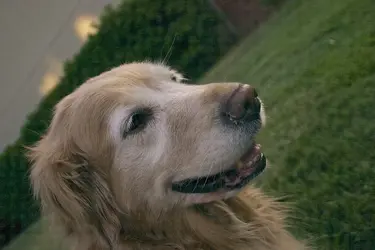Not bad for just a couple of days

#1: Not crazy about the tilt. The light is also flat and not interesting. It's good that you're experimenting with the settings on the camera, but never forget that it's all about light. Pay attention to the light that you have. I see a couple of patches of light in the background. Think about how you can place your subject in relation to that more interesting, directed light.
#2: Better light, but the dogs' faces are in the shadows, so your camera exposes for the brighter spots, but leaves the faces in shadow, so you lose detail in the more important subjects. Not a lot of detail in this case, but the eye is still pulled more towards their butts because they are brighter, and the eye moves towards brighter areas in the image. In terms of the composition, it's good framing, though you cut off the paws and you could leave more room on the left side.
#3: I'd say this one is the most successful one. Good light and exposure, good focus on the dog's eyes, great expression. I'm not sure if you framed it that way or cropped it that way - I notice that there's some clutter in the background. The dog's face takes up so much of the frame that you can't help but notice it, but you wouldn't need to crop/frame so tightly if you pay more attention to background to make sure it's less cluttered and not distracting. This particular image is okay cropped that tightly - I'd personally like a tad more breathing space, but it's not bad.
#4: It's tilted slightly, so could use some straightening, and the light seems a bit bright in the dog's face, but not distractingly so. For this shot, I'd play with a wider aperture (which means the lower numbers - higher numbers mean the aperture is smaller). That will keep your subject in focus but will blur the background more. It's a useful trick when you want to minimize the background and isolate the subject more effectively. Of course, you would have to compensate with a faster shutter speed so you don't overexpose, and you have to be more careful with your focus. A wider aperture will give you a smaller area that will be in focus (this is known as depth of field) so there is a smaller margin of error when it comes to focus.
One more note: you don't have to rely on your dog as a model. You don't need a model at all to practice!

I suggest making a concerted effort to notice light for the next several days: where does it fall? When is it bright? How do shadows fall? How much of a contrast is there between a shadowed area and a lit area? Where does the light come into the house at different times of the day? Where is the line between bright light and harsh light?
Follow the light and you'll always have something to take a picture of

Good luck and keep posting!











![[No title]](/data/xfmg/thumbnail/31/31979-ea92aca54ae865842d998c9cec534991.jpg?1734160756)




